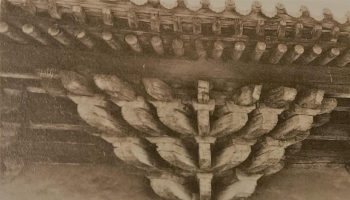Stepping foot into the rainforest of Victoria’s Central Highlands is an experience so heightened I’m left wondering if the scene before me is by mere happenstance or is indeed the product of careful orchestration. I can’t turn without feeling the delicate fronds of ferns caressing my skin, or hearing the exquisite birdsongs fall against my ears as refreshing as waterfalls.
The large Myrtle Beech trees sway delicately in the breeze as I amble after Gretel, who leaves me in familiar pursuit. Distracted by the magic of the forest, I don’t realise how far we’ve wandered until Gretel suddenly exclaims, “Over here!”

I turn to see a clearing and blue sky. A rocky mountain stream cuts through the landscape like a bolt of lightning. It is here we hope to find what we’re looking for: the elusive spotted tree frog. According to Gretel, a herpetologist at Zoos Victoria, this is one of only 17 streams in Australia where this species can still be found. With that in mind, we set about foraging amongst the loose rocky banks and streamside vegetation. Soon, the sky turns to a dusky purple littered with glimmering of stars, and the whispering of leaves is replaced by chirruping crickets.
“I’ve found one!” I hear Gretel yell.
As I approach, I catch a glimpse of a webbed foot between Gretel’s fingertips. She gently passes the frog to me and I crouch beside the riverbank, unfurling my fingers one by one. What I see before me is an unassuming olive-grey creature covered in numerous raised ‘warts’. As I turn the frog over in my hands, I notice its underside is pale, and its rear and back legs are flushed with pastel orange. Its toes and fingers are distinctly flattened, and the toes are fully webbed. Its head is relatively broad and a pair of huge amber eyes stare back at me with curiosity.

“Is this a male or a female?” I ask.
Gretel as she rummages through her backpack and brings out a tape measure, notepad and pen. She asks me to place the frog on its stomach, and carefully measures its length.
“61 millimetres,” she notes. “That’s about as large as they get. It must be a female.”
I take one last look at the frog, giving her an affectionate stroke before releasing her back into the stream.
About twenty minutes later, with the help of Gretel’s flashlight, we come upon two more frogs nestled among some loose stones. But even before Gretel warns me, I can tell these two are different. They appear malnourished, and their hind legs are postured abnormally. When Gretel leans over to capture one, it barely has the energy to attempt an escape.
“What’s wrong with it?” I ask.
“Chytridiomycosis,” she replies, taking a scraping of the poor creature’s skin.
I look at her inquisitively.
“It’s a fungus that’s recently been found in the skin of some Australian frog species,” she begins, a note of remorse in her voice. “We don’t really know the impact these infections are having on this species’ population yet. It could cause the population to decline, or it could be a symptom of some other environmental stress. All we know for sure is that before the population crash in 1996, several dead and infected individuals were found.”
“Is anything being done about it?”
Gretel captures the other frog, its half-closed eyes glisten in the moonlight.
“Well the Department of Environment and Heritage revised their Threat Abatement Plan in 2016 to help research and combat these infections,” she replies, “but at the moment it’s hard to see light at the end of the tunnel. There are so many other factors threatening this species.”
“Such as?”
“Timber harvesting, gold dredging, recreational activities, weed invasion, introduced species, herbicides, just to name a few.”
I can tell by the tone of her voice that she’s rattled off this list before.
“And how exactly do these disturbances affect them?” I ask as we head back to Gretel’s Land Rover.
“They change the habitats in or around the streams, which potentially affect the survival of eggs or tadpoles. And of course, introduced fish like Rainbow Trout and Brown Trout prey upon them heavily in the summer months when the larvae grow into tadpoles.”
We walk the rest of the way in silence. The same earthy smell and marriage of sounds which had enchanted me on the trek inward now seemed to jolt me; I had discovered the yolk of unforgiving cruelty that lay beneath its beautiful façade.
“It’s not all bad, you know,” Gretel says as she slumps into the driver’s seat of the car, preparing for our journey home.
While Gretel drives, she explains to me that the spotted tree frog is listed as an endangered and threatened species under numerous acts in Victoria and New South Wales. It is also considered critically endangered by The International Union for Conservation of Nature. Accordingly, preparations for recovery plans are underway in Victoria and NSW. A National Recovery Team has been established to oversee and direct research of the species, and surveys of the populations and their habitats are being conducted. Conservation has also been promoted through media releases and educational materials for other interest groups.

But perhaps the most hope-inspiring of Gretel’s tales is that of the captive breeding program coordinated by Zoos Victoria, where frogs are bred at Healesville Sanctuary before their reintroduction into the wild. By establishing this captive population, Zoos Victoria, in partnership with the government and stakeholders, has made it their mission to ensure the survival of the spotted tree frog (and all Victorian terrestrial vertebrate species) for at least another five years. So far, the program has proven successful, with a record number of captive eggs and tadpoles produced during 2011/2012 breeding season. And our visit today contributes to Gretel’s regular assessment of the reintroduced individuals and monitoring of the population, a critical part of this program’s ongoing evaluation of the species’ conservation status.
As we re-enter the city, I sit in the Land Rover, sip my soda and watch the pedestrians pass by. It would be all too easy, I thought, for the plight of a little frog to fall upon deaf ears. After all, the tales of centuries past have told of many animals succumbing to a shroud of deepening indifference. For a moment, I ponder as to why this humble creature has touched my heart. Gretel’s knowledge enabled me to understand its biology, its ecology, and its general way of life, and the quiet moments we spent observing these frogs allowed me to see its true nature, an animal of high intelligence, charisma and grace. Both of these experiences offered lessons for those willing to hear them, and beauty for those willing to see it.
Driving through the streets, we pass a derelict house with an old street sign nailed to a tree by the gate. Gretel slows the car. “Look,” she says, pointing to the sign. A narrow beam of moonlight pierces through the clouds and illuminates the first word, HOPE.


